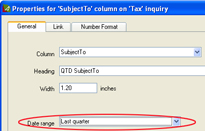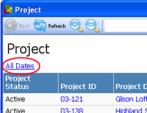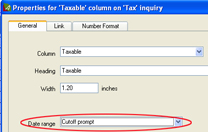Displaying data in a column for a specific time period
For many date columns and certain columns that contain dollar amounts or hours, you can select to display only data for a specific time period.
To determine if a column accepts a date range, right-click the column and click Properties to see if the General tab contains the Date Range field.
You restrict data that appears in a column by using the Column Properties window. In that window, you can assign the column one of the following:
| Note: |
For example, you set a condition on the Vendor Invoice inquiry that the invoice amount must be greater than $500. You then apply a date range of Range Prompt to the Invoice Amount column. Any invoices with amounts less than $500 and not within the range prompt entered are omitted. |
Assigning a cutoff date or date range
- Right-click the column heading (where you want to display only information which occurs on or before a specific date or within a range of dates), and click Properties.
- In the Date Range field, select either Cutoff prompt or Range prompt.
| If you select | Then |
|---|---|
|
Cutoff prompt |
Ajera assigns the current date as the cutoff date and displays it at the top of the inquiry in blue underlined text. To change the cutoff date, click the blue underlined text, and select a date |
|
Range prompt |
Ajera displays All Dates at the top of the inquiry in blue underlined text. If you assigned a cutoff prompt to another column in the inquiry, the blue underlined text appears as 01/01/1900 - <current date >.
Click the All Dates text, and select the date range you want to assign to the column. |
| Note: |
If you set different cutoff or range dates for other columns, the prompt at the top applies to all columns where you assigned date conditions. If you have a mixture of cutoff and range dates, the cutoff condition uses the latest date in the date range.
|
Assigning a time period based on the current date or cutoff date
In addition to the Cutoff Prompt and Range Prompt, other options are available. These options, such as 91 to 120 days ago are helpful when you want to view aging (such as client invoice aging) or payroll information (such as QTD ).
Ajera bases the time period on the current date. However, if you already used a cutoff date for another column, then it uses the cutoff date, which appears in blue underlined text at the top of the inquiry.
- Right-click the column heading you want to show and click Properties.

- In the Date Range field, select the option you want.
- Click OK.


